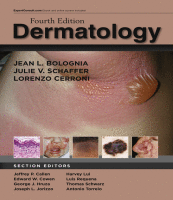Physical Address
304 North Cardinal St.
Dorchester Center, MA 02124

Synonyms ▪ Verrucae vulgares (singular: verruca vulgaris) – common warts ▪ Verrucae palmares et plantares – hand and foot warts ▪ Verrucae planae – flat warts, plane warts ▪ Condylomata acuminata (singular: condyloma acuminatum) – genital warts ▪ Condylomata plana…

Key features ▪ A broad spectrum of infectious, inflammatory, and neoplastic skin conditions may occur in the setting of HIV-induced immune dysfunction ▪ The cutaneous findings often correlate with immune status, and knowing the viral load and CD4 + T-cell…

Key features ▪ Cutaneous fungal infections are broadly divided into two groups: (1) those that are limited to the stratum corneum, hair, and nails; and (2) those that involve the dermis and subcutaneous tissues ▪ Superficial fungal infections of the…

Key features ▪ Rickettsiae are small, obligately intracellular, Gram-negative bacteria that reside within an arthropod host (tick, flea, louse, or mite) during part of their life cycle ▪ The arthropod vector transmits the rickettsiae in its saliva or feces during…

In 1896, the name “mycobacteria” was given to a large group of bacteria that produce filamentous pellicles similar to molds when grown in liquid media. These organisms are thin, slightly curved to straight, non-motile and non-spore-forming, with a waxy coating…

Key features ▪ Roughly 20% of outpatient dermatology visits are for bacterial skin infections ▪ Staphylococci and streptococci cause the majority of bacterial skin conditions, which range from common infections (e.g. impetigo) to multisystem disorders (e.g. toxic shock syndrome) ▪…

Introduction The diagnosis and management of skin diseases in the anogenital region may be complex. The juxtaposition of urinary, genital and alimentary tracts gives rise to special considerations at this site ( Fig. 73.1 ), and disease of any of…

Introduction From both a clinical and histologic standpoint, the oral cavity is an amazingly diverse anatomic region. This is not surprising when one considers the various tasks and environmental interactions that take place within the mouth. Sites that are associated…

Anatomy Key features ▪ Nail matrix → nail plate production proximal matrix → dorsal nail plate distal matrix (lunula) → ventral nail plate ▪ Proximal nail fold → nail matrix protection ▪ Nail bed and hyponychium → nail plate adhesion…

Key features ▪ Hypertrichosis refers to excessive growth of hair anywhere on the body, whereas hirsutism represents excessive hair growth within androgen-dependent sites in girls and women ▪ Hypertrichosis may be generalized or localized, with etiologies ranging from genodermatoses to…